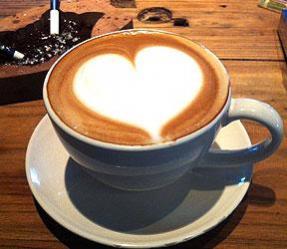Grind the coffee into gold
Schultz's old mother may not have read the Fortune report. Once, she was accompanied by her son to visit the Starbucks Center in Seattle. After wobbling past many departments and studios, she pulled her son to her side and whispered, "who pays these people?" Because the scale of the center is completely beyond her imagination.
If the old mother knew how big her son's career was, she would probably be "scared"-since becoming chief executive of Starbucks, Schultz has turned the company, which used to have only six stores and fewer than 100 employees, into a world-class company with more than 1300 stores and 25000 employees, the fastest-growing company in the United States in 20 years.

"enough is not enough."
Schultz never had a "boss dream" in his childhood. At that time, coffee was of little importance in life. We drank instant coffee at home. Only when guests came, my mother would buy canned coffee and take out the old coffee pot.
In 1961, Schultz was just seven years old. One day, his father broke his ankle at work. For some time since then, my father's feet have been wrapped in plaster, tilted on the sofa, can not go out to work. The Schultz family was immediately thrown into the bottom of society. Years later, the injuries of his father and the lack of means of his family still appeared in front of Schultz from time to time.
Schultz grew up slowly in a difficult environment. He doesn't know what he can do in the future, but he knows that he must leave the environment where his parents live and leave low-rent housing. He once wanted to be a sports star and earn a lot of money to live a good life. But in the end, he didn't get what he wanted. When he graduated from college, Schultz helplessly became a salesman in New York, and then, like all "mortals", got a wife and lived a happy life.
1982 was a memorable year for Schultz. The 28-year-old bought an apartment in Manhattan and said goodbye to low-rent housing. He and his wife often go to the theatre and invite friends to have parties at home. Most people would be satisfied with such a life, but Schultz said to himself, "enough is not enough."
"I am in the kingdom of God."
Schultz is a thoughtful man. For a while, he noticed a strange thing: a small retailer in Seattle ordered a large number of coffee grinders from him, even more than the largest department store in New York. After investigation, he found that the small retailer was a coffee bean, tea and spice store called Starbucks.
Schultz decided to take a look. On a fine spring morning, he flew to Seattle. It is an unadorned place. The moment the door was pushed open, a smell of coffee wafted in. When he walked into the cabin, he found himself "falling" into the hall of coffee. Behind the counter are cans of coffee beans from all over the world; on one wall, coffee grinders bought from him are displayed.
In a dark room upstairs, Schultz met Starbucks bosses Jerry Baldwin and Gordon Parker. Starbucks opened in 1971 in the hands of these two friends. They don't sell brewed coffee, but only coffee beans. Sometimes, they put the coffee made from samples in porcelain cups for people to taste, so that customers can stay in the store longer. Schultz was fascinated by the story of the two small bosses.
Inspiration from Italy
It took Schultz a year to convince Jerry Baldwin to hire him as a marketing executive at Starbucks. In the months that followed, he spent all day behind the counter, receiving customers and familiarizing himself with different flavors of coffee.
In the spring of 1983, Schultz went to Milan, Italy, to attend an international exhibition. One day, as soon as he walked out of the hotel, he noticed a small coffee shop not far away. He pushed the door in, and the barista greeted him happily and quickly made a cup of coffee. Half a block further, Schultz saw another coffee shop. He saw that the gray-haired old man behind the counter could call out each other's name when he greeted each customer. They laughed and chatted together and had a good time together. Go straight ahead, there is an open square. As soon as Schultz was in it, he was surrounded by incredible romance and community atmosphere. One coffee shop after another, shrouded in lively music, people greeted each other like old friends, and baristas performed "perfectly" with extraordinary talent.
All of a sudden, Schultz came up with a "revolutionary" idea: that's exactly what Starbucks is missing-they sell only high-quality coffee beans to customers, but no coffee to be tasted, let alone a human coffee culture. Maybe he can add a great experience to American life.
"Great experiment."
At this time, Starbucks is still a "nest" of coffee bean shops in Seattle. It also took Schultz a year to persuade the boss to supply coffee drinks to customers. In April 1984, Starbucks opened its sixth store. It became the first Starbucks store to serve both coffee beans and drinks.
At seven o'clock sharp, Schultz opened the door excitedly. People at work strolled in curiously. Many people ordered espresso on the Italian drink list. The barista prepared the new drink happily and quickly, smiling and explaining to the customers. Latte, cappuccino... These brands of coffee were introduced to the United States this morning.
Schultz carefully watched the customers' reaction to the first sip of coffee. Many people keep their eyes wide open. This is the first reaction to such a strong taste that is unfamiliar. They hesitated for a moment, took another sip, and then began to enjoy the warm fragrance. Schultz was pleased to find that no one was interested in the coffee beans on the other side of the counter.
Looking at the scene in front of him, Schultz knew that Starbucks' history was about to change dramatically and it was impossible to go back.
The salmon swallowed the whale
The success of the new business has not led Starbucks bosses to support Schultz.
After months of depression, Schultz finally decided to leave Starbucks and set up another door. He named the new company Tiantian. Schultz's ideal ship set sail. He plans to open a store first, which requires him to raise at least $400000 in venture capital; after that, he plans to open eight more coffee shops with $1.25 million.
April 8, 1986 is the opening day of Tiantian. Schultz came to the store early and looked nervously around. At 06:30 in the morning, the first customer was waiting outside the door. She came in and bought a cup of coffee straight away. Then, there were more and more customers, and everyone greeted and chatted cordially. This atmosphere is exactly what Schultz wants most.
But Schultz soon ran into trouble-- the venture capital was running out. In addition, he thought that it would take only six months to absorb all the funds needed to implement his second-step plan. But in fact, the process took two years. In the meantime, he borrowed money from 242 people, but 217 told him "no". Schultz later recalled that in those days, he was like a dog with a tail between its legs.
In August 1986, Schultz finally ran out of ammunition. He decided to visit the three most famous business leaders in Seattle. The meeting was held on the top floor of the tallest business building in Seattle. Schultz walked around the block three times to appease his frantic heartbeat. In the end, his presentation and lobbying were a great success-entrepreneurs decided to spend 750000 dollars. Today, these initial investors have made a 100-fold return.
Just then, Schultz got the news that his former boss was going to sell Starbucks. He went there at once. At that time, Starbucks was much larger than Tiantian. It's like a salmon swallowing a whale and a son leading his father. But for Schultz, this is not a problem at all. Investors put their trust in him again, scraping up the $4 million he needed to buy Starbucks.
On a sunny afternoon in 1987, Schultz signed a document to buy Starbucks. Then, as usual, he came to the coffee shop, said hello to the barista easily, and sat down on a stool by the window. By this time, he had changed from a former employee to the president of Starbucks. The clerks saw that their boss picked up a cup of coffee with tears in his eyes.
Important Notice :
前街咖啡 FrontStreet Coffee has moved to new addredd:
FrontStreet Coffee Address: 315,Donghua East Road,GuangZhou
Tel:020 38364473
- Prev

The bakery can also sell coffee. The country's first food business "mash-up" license has been issued.
Xinhua Wuhan, July 10 (Reporter Liao Jun) now only need 4 pages of paper, only 4 working days to get the certificate. On the 9th, Yin Hao, the owner of a West Point coffee shop in Wuhan, received a food circulation license for both food circulation and catering services. This is the first relevant license issued by Wuhan since the policy of combination of two licenses for mixed food business license was first issued in the country.
- Next

Reduce the price of Aisha coffee to celebrate a bumper harvest
The official Sina Weibo and the official website at the same time issued a notice of price adjustment: from now on, the prices of roasted beans and Italian blended beans in the country of origin of Aiju coffee will be reduced to varying degrees, with a maximum price reduction of 22%. In addition, the original prices of other products such as Manaka, coffee gift boxes and coffee machines remain unchanged.
Related
- What brand of black coffee is the most authentic and delicious? what are the characteristics of the flavor of the authentic Rose Summer Black Coffee?
- Introduction to the principle and characteristics of the correct use of mocha pot A detailed course of mocha pot brewing coffee is described in five steps.
- Which is better, decaf or regular coffee? how is decaf made?
- How much is a bag of four cat coffee?
- How about four Cat Coffee or Nestle Coffee? why is it a cheap scam?
- Which is better, Yunnan four Cats Coffee or Nestle Coffee? How about cat coffee? is it a fake scam? why is it so cheap?
- How about Cat Coffee? what grade is a hoax? which instant coffee tastes better, four Cat Coffee, Nestle Coffee or G7 coffee?
- Process flow chart of coffee making-Starbucks coffee making process what coffee tastes good at Starbucks
- The top ten best coffee beans in the world Rose summer coffee or Tanzanian coffee tastes good
- Yunnan four cat coffee is good to drink?_four cat coffee is a big brand? four cat blue mountain coffee is fake?

